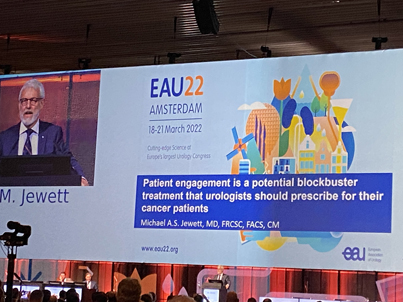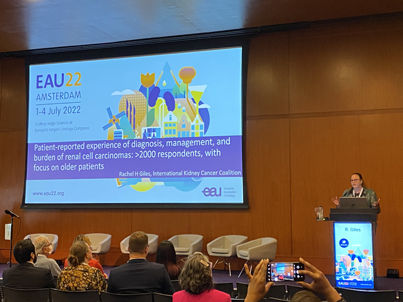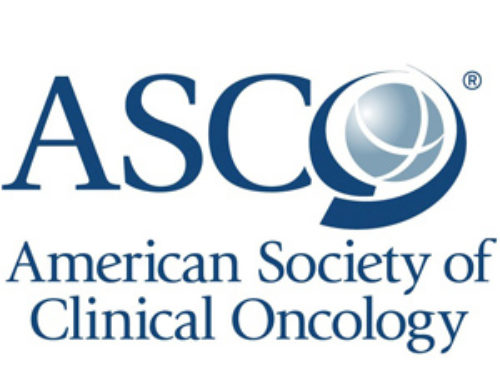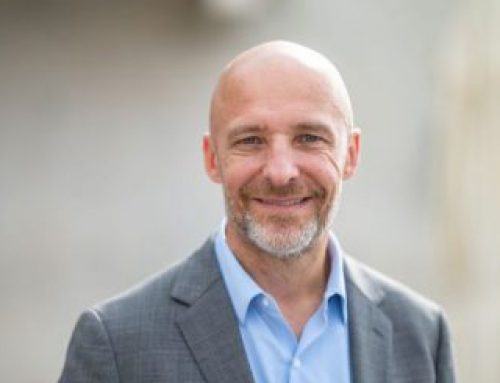This year’s European Association of Urology (EAU) Annual Meeting was held from 1-4 July 2022 in Amsterdam, the Netherlands. Members of the IKCC Board and staff attended the meeting, and the IKCC had a booth in the exhibition hall. Dr Michael Jewett, Professor of Surgery (Urology) at Princess Margaret Cancer Centre and the University of Toronto and member of the IKCC Board of Directors, gave a presentation about patient engagement in healthcare decisions. Dr Rachel Giles, chair of the IKCC Board of Directors, chaired a session about kidney cancer and presented a poster. Here are the highlights from each of these sessions.
Please note: The following summary was prepared for the benefit of patient advocates and patient organisations around the world who focus on kidney cancer. While this summary has been medically reviewed, the information contained herein is based upon public data shared at this meeting and is not intended to be exhaustive or act as medical advice. Patients should speak to their healthcare professional about their own care and treatment.
Patient engagement is a potential blockbuster treatment that urologists should prescribe for their cancer patients
 During the past 50 years as a urologist in Toronto, Dr Jewett has seen an evolution of his own philosophy and a huge transformation in the use of the patient voice to deliver high quality care. Over the past 40 years, there has been an evolution in patient-centred care. There have been a couple of standout publications: The first was from the Institute of Medicine in America 20 years ago. This study focused on quality of care, and respect of the individual and their preferences and values to guide clinical decisions. It concluded quality “care that is respectful of and responsive to individual patient preferences, needs, and values guide all decisions”.
During the past 50 years as a urologist in Toronto, Dr Jewett has seen an evolution of his own philosophy and a huge transformation in the use of the patient voice to deliver high quality care. Over the past 40 years, there has been an evolution in patient-centred care. There have been a couple of standout publications: The first was from the Institute of Medicine in America 20 years ago. This study focused on quality of care, and respect of the individual and their preferences and values to guide clinical decisions. It concluded quality “care that is respectful of and responsive to individual patient preferences, needs, and values guide all decisions”.
The second publication from the Institute of Medicine 10 years later focused on high quality care delivery systems and patient-centred care. The patient is at the centre of the care delivery system with the clinical workforce around the patient.
These studies have produced high level evidence and quality improvement strategies for patient care. These strategies involve patients in every aspect of decision-making. Over the past 20 years, this has led Dr Jewett to support national advocacy groups in bladder and kidney cancer. He has also been involved with the IKCC over the last 7 years. The EAU has been outstanding in identifying the value of involving patients in decisions about their care.
How can clinicians do more to support patients from the bottom up and engage with this initiative? Hopefully, this presentation from the IKCC will persuade clinicians of the value of patient engagement.
A study published in 2017 in the Journal of the American Medical Association was presented at the American Society of Clinical Oncology Annual Meeting (ASCO 2017) plenary session. This study included over 700 American patients with metastatic disease. Half of the patients had access to a reporting system that allowed earlier therapy change. There was an overall survival benefit of about 10% compared to those who had standard care. This study showed that this engagement strategy could be considered a ‘blockbuster’ treatment and clinicians should ‘prescribe’ this for their patients.
The objectives of Dr Jewett’s presentations were to:
- Understand what patient engagement means and how it applies to different health care systems and cultures
- Review the known impacts in terms of improved quality of life, reduced legal actions, less hospital visits and calls
- Review the impact of patient engagement on cancer survival
- Develop strategies to encourage patients to take part in engagement activities, including advocacy groups and patient education programmes. Encourage patient-centred care by multidisciplinary teams, provide timely access for side effect reporting, and the use of social media and other communication tools.
What is patient engagement? Patient engagement is encouraging patients to manage their own health care. This includes increasing awareness and taking better care of their own disease or condition.
A literature review of 82 randomised controlled trials of cancer patient engagement showed that 90% of the trials included quality outcomes, emotional wellbeing, coping strategies, physical wellbeing, quality of life and self-care. In half of these studies, survival was measured and improved, showing that patient engagement prolonged life. In one study, breast cancer patients had 5-weekly psychological support and education sessions resulting in improved survival. The literature review also showed that physical exercise reduces anxiety and depression, and improved survival in leukaemia patients.
Dr Jewett then presented a summary of the activities of the IKCC, including the annual meeting to share best practices, World Kidney Cancer Day, and participation on guideline committees for kidney cancer. It is becoming more popular to recognise the patient voice in kidney cancer treatment guidelines. Dr Jewett also talked about the clinical trial infographics for patients and clinicians, and the shared decision aids.
Patients should also be involved with setting research priorities for kidney cancer. Patients have been invited to a workshop at the European Society of Medical Oncology (ESMO) Annual Meeting in the autumn to discuss the science of advocacy with clinicians and hopefully raise awareness of the value of patient advocacy.
Dr Jewett summarised by saying that there is now a little more understanding of what patient engagement means and what its impact is, including on cancer survival. Patients should be encouraged to take part in engagement activities. The hope is that one day this will be commonplace in health care and it will be a cheaper way of improving survival.
Watch Dr Jewett’s presentation here
Age differences in patient-reported experience of diagnosis, management, and burden of kidney cancer
The number of people with kidney cancer is rising around the world, increasing the burden on patients, their families and healthcare systems. There is a lack of evidence about the treatment preferences and experiences of patients, which varies between countries. Data from the second biennial worldwide IKCC Global Patient Survey of diagnosis, management, and burden of kidney cancer was presented by Dr Giles, with a focus on older patients. Dr Giles also identified unmet needs of kidney cancer patients leading to research priorities.
The aim of the survey was to improve understanding and contribute to reducing the burden of kidney cancer. Patients and caregivers completed a 35-question survey to identify differences between countries in patient education, experience and awareness, access to care and clinical trials, best practices, quality of life, and unmet psychosocial needs. The survey was distributed in 13 languages via IKCC’s 46 Affiliate Organisations and social media. The data were collected and analysed independently.
Over 2,000 patients from 41 countries responded to the survey. The full global report is available on the IKCC website. In terms of diagnosis, 44% had metastatic disease, 23% had localised kidney cancer, and a third had no evidence of disease (i.e., their tumour had been removed and the cancer could not be detected). Patient experiences differed depending on the availability of treatment options in their country.
In terms of treatment, many patients didn’t understand their prognosis; 42% reported that the likelihood of surviving their cancer beyond 5 years was not explained. Patients aged 65 and older experienced more barriers to quality care, understood their disease less well, and waited longer for a diagnosis.
Just over half (51%) of the patients surveyed felt they were involved ‘as much as they wanted to be’ in planning their treatment. In addition, 56% of patients experienced barriers to treatment. Just over half of the younger patients (less than 46 years) did not know the subtype of their kidney cancer.
Clinical trials were not discussed with less than half of the patients surveyed (41%); only one-third (31%) were invited to take part in a clinical trial. Also, less than half of the patients (46%) had a biopsy and only 3% said they were not willing to have an additional biopsy, if asked.
In terms of self-care and quality of life, 45% of patients said they were not physically active enough. More than half of the patients (55%) ‘very often’ or ‘always’ experienced fear of recurrence.
When looking at older patients (aged over 66) specifically, they didn’t understand the 5-year risk of recurrence or death when they were diagnosed with kidney cancer. However, older patients were more involved in treatment planning decisions, which points to the need to involve younger patients in shared decision-making.
Patient-generated data such as this is evidence-based and can be used to improve the EAU guidelines for the treatment of kidney cancer.
Thank you to the IKCC and its global Affiliate Organisations, who will be using these results to ensure that the patient’s voice is heard in their individual countries to support improvements in local care.
The benefit of kidney cancer hospital networks
Dr Patricia Zondervan, Urologist from the Amsterdam University Medical Centre, talked about multidisciplinary kidney cancer boards operating across hospitals to improve learning and exchange information for the benefit of patients.
The incidence of kidney cancer varies around the world. The highest rates are seen in the Czech Republic and North America. Worldwide, there are over 400,000 new cases each year and over 170,000 deaths from kidney cancer. About two thirds survive for 5 years after a diagnosis, and about half survive for 10 years.
Dr Zondervan started her presentation by talking about the multiple treatment options available to people with small renal masses, such as partial nephrectomy, robotic surgery, and procedures that destroy the kidney tumour, such as cryoablation and radiofrequency ablation.
The number of small renal masses that are diagnosed is increasing and has doubled from 1975 to 2011. Advances in diagnosis and treatment have resulted in improved survival with three quarters of patients with small renal masses living for at least 5 years.
The focus of treatment for small renal masses is to keep as much kidney tissue remaining as possible i.e., kidney sparing treatment. Partial nephrectomy is currently the gold standard treatment for small renal masses less than 7 cm in size. Kidney function, the age of the person and any additional diseases or conditions need to be considered. Partial nephrectomy is a complex operation. However, the use of robotic surgery reduces complications, such as urine leakage and bleeding. However, this surgery is less invasive, but expensive.
Ablative therapies, such as cryoablation and radiofrequency ablation, have developed over the past few decades. The aim of these treatments is to destroy cancer cells by directing extremely high or low temperatures directly into the tumour while sparing healthy kidney tissue.
When deciding which treatment to have, patients need to be involved in the decisions along with their clinicians i.e., shared decision-making. This is important for all stages of kidney cancer, including small renal masses, locally advanced kidney cancer, and metastatic kidney cancer. This is where expert Multidisciplinary Tumour Boards (MTBs) are key.
MTBs consist of several experts from different hospitals. With more experts on board, there is more discussion about treatment options. There is less bias towards one type of treatment in one hospital and the expertise is spread across hospitals. There are more options for patients. Patients deserve to get the best possible advice about their cancer treatment that is not hampered by selection bias.
In the Netherlands, the Kidney Cancer Network Amsterdam was started by urologists with the aim of improving and learning from each other for the benefit of the patients. They are patient-centric and aim to improve quality of care for kidney cancer patients. They collaborate in research studies and the sharing of data improving value for all healthcare professionals. They also provide multidisciplinary training of new healthcare professionals and researchers. There is a central MTB for all hospitals in the area. This board meets via video conference to discuss all people with suspected kidney cancer. Patients are involved in shared decision-making. In the past 3 years there have been 134 MTB meetings where nearly 2000 cases were discussed.
For most patients (97%), the advice of the MTB was followed. Reasons for not following their advice included second opinions, deterioration, and patient decision. Shared decision-making was possible in just over a quarter of all cases. Only 3% of patients were included in clinical trials due to COVID-19.
Keeping kidney cancer expertise together in networks, such as the Kidney Cancer Network Amsterdam is important to increase the number of patients that can be discussed, increase shared decision-making, and to recommend patients for clinical trials and research.
Shared decision-making in kidney cancer
Dr Harm van Melick, a urologist from Nieuwegein in the Netherlands, gave an interesting talk about shared decision-making for kidney cancer patients.
There are many treatment options for people with kidney cancer. Decisions about treatment options can be made by the healthcare professional only (paternalistic decision-making), the healthcare professional and patient together (shared decision-making), or the patient using information from the healthcare professional (informed decision-making).
Traditionally, the healthcare professional made the decision about treatment using evidence-based research. Recently, healthcare professionals have been using a more patient-centred approach where the patient is educated in their disease and empowered to make decisions in partnership with the healthcare professional.
Shared decision-making is a joint process in which the healthcare professional works together with the patient to reach a decision about care. It involves choosing tests and treatments based both on evidence and on the patient’s individual preferences, beliefs, and values. It makes sure the patient understands the risks, benefits, and possible consequences of different options through sharing information and discussion.
Shared decision-making became a concept in 1997. It gave people autonomy and allowed variation in healthcare practices, preferences, and available treatment options. In the last decade, it has received more attention.
The process of shared decision-making involves:
- Seeking the patient’s participation
- Helping the patient explore and compare treatment options
- Assessing the patient’s values and preferences
- Reaching a decision with the patient
- Evaluating the patient’s decision.
Patients want to be involved in decisions about their treatment options. A Dutch survey showed that 90% of patients wanted to take part in shared decision-making. The advantages of this are patients are more satisfied with their treatment, there is better compliance with taking medication, patients feel involved and informed, and all this results in better health and quality of life. Disadvantages include doubt and regret about choosing the right treatment, increased costs and operations. In the Netherlands, shared decision-making also resulted in less variation between hospitals in their treatment options.
Dr van Melick went on to talk about the benefits of using decision aids for shared decision-making. Decision aids contain easy to understand and relevant information about the patient’s diagnosis. They highlight the pros and cons of each treatment option. They also contain questions that give patients a better idea of preferences and values. Shared decision-making is mentioned in the EAU oncology guidelines, and already there are shared decision aids for prostate and kidney cancer.
The IKCC has produced a series of ‘My treatment, my choice’ shared decision aids for small renal masses, locally advanced kidney cancer and metastatic kidney cancer, and is currently working on a decision aid for clinical trials. They can be found on the IKCC website here.
Dr van Melick concluded by saying that shared decision-making is very helpful in many ways to improve the quality of care. It is an important part of empowering patients to make decisions about their own care and treatment. However, more decision aids are needed for kidney cancer.
First national integrated care pathway for VHL patients
 Dr Rachel van Leeuwaarde, from the University Medical Centre in Utrecht, the Netherlands, gave an interesting talk about the first national integrated pathway for von Hippel-Lindau (VHL) patients.
Dr Rachel van Leeuwaarde, from the University Medical Centre in Utrecht, the Netherlands, gave an interesting talk about the first national integrated pathway for von Hippel-Lindau (VHL) patients.
VHL disease is a rare inherited condition that causes tumours and cysts to grow in certain parts of the body. The tumours are usually not cancer (benign), but in the kidney they are. Patients with VHL need lifelong screening from an early age. This includes numerous medical specialists because of the variety of organs that can be affected (brain, spinal cord, eyes, inner ear, adrenal glands, pancreas, kidney, and reproductive tract). Patients need a complex screening schedule and a multidisciplinary integrated care pathway.
Multidisciplinary care pathways are ‘structured, multidisciplinary care plans that provide professionals with detailed guidance for the care of patients with a specific problem to translate evidence to practice in order to optimise clinical outcomes and maximise clinical efficiency’.
The framework for a multidisciplinary care pathway is based on national or international guidelines and criteria for quality care from the patient perspective. The criteria for the VHL care pathway are:
- The healthcare provider recognises VHL as a chronic physical condition
- The specialist nurse raises awareness of VHL symptoms with the family doctor (in the Netherlands)
- VHL patients are treated by healthcare professionals who are familiar with VHL and have sufficient experience treating VHL patients
- The specialist nurse or family doctor raises concerns about symptoms that may be related to VHL
- The healthcare professionals know the signs and symptoms, and the impact of VHL on the patient
- The healthcare professional considers the impact of the condition on the patient’s ability to work and their prognosis
- The patient (and caregiver or family member) receives extensive (oral or written) information about VHL, including treatments and counselling
- The patient is monitored and treated at the correct times using an integrated care pathway for VHL.
Based upon these criteria, the first national integrated care pathway for VHL patients has been put into practice in the Netherlands. The pathway takes the form of a ‘road map’, and includes multidisciplinary team meetings, dedicated specialist nurses, psychosocial screening tools, case managers and family planning services.
The care pathway has resulted in a reduction in the number of complaints to the hospital, improved documentation, reduced hospital stays, decreased hospital costs, and there is less variation and disparity between hospitals in treatments.
The multidisciplinary team should include several specialists to enable screening and treatment of VHL patients, including a coordinating VHL specialist, urologist, neurologist, neurosurgeon, ophthalmologist, radiotherapist, paediatrician, oncologist, endocrinologist, clinical geneticist, dedicated specialist nurse and, of course, a patient.
Acknowledgements:
Editor: Dr Rachel Giles (NL)
Medical Writer: Dr Sharon Deveson Kell (UK)



